By 1941, public opinion on whether or not the U.S. should get involved in the fighting in Europe was decidedly mixed. One place that wasn’t quite so conflicted was the comic books, particularly the comics published by Timely. Having already had a taste of success with Carl Burgos’ Human Torch feature and Bill Everett’s Sub-Mariner character, Timely opted to go for broke with their newest creation. Capitalizing on the jingoistic national mood of a country on the brink of war, the company’s publisher, Martin Goodman, enlisted the already-established creative team of Joe Simon and Jack Kirby to create him a patriotic hero, one that the company, and ideally readers everywhere, could rally around.
Simon and Kirby more than came through when they delivered Captain America to Timely. Goodman must have been impressed, because Captain America was the first Timely character to make his debut in the pages of his very own magazine, namely the March 1940 issue of CAPTAIN AMERICA COMICS.
Unlike many comics of the period, CAPTAIN AMERICA COMICS actually bothered to start off the series with a proper origin, and it is here that we begin our look back at the greatest of comics’ patriotic heroes.
The tale opens with the destruction of an American munitions factory (helpfully labeled “AMERICAN MUNITIONS INC.” on the side of the building) by Nazi agents working undercover in the United States.
This and other acts of sabotage have spurred President Franklin Delano Roosevelt to the creation of a new project to stem this wave of destruction, and he sends several military leaders to personally witness the culmination of the plan.
The military brass are escorted by a female agent, disguised as an aged shopkeeper, to a secret laboratory, where they sit to observe the results of years of research. Entering the lab is a frail, skinny young man, who, declares the scientist injecting him with a mysterious seething liquid, “volunteered for army service, and was refused because of his unfit condition.” Within moments, the young volunteer, Steve Rogers, is transformed into a perfect specimen of humanity, as Professor Reinstein boasts: “The first of a corps of super-agents whose mental and physical ability will make them a terror to spies and saboteurs.”
Professor Reinstein’s triumph would be short-lived, however. Just as the scientist dubs Rogers “Captain America” (“because, like you – America shall gain the strength and the will to safeguard our shores!”), one of the military observers reveals himself to be a traitor, pulling out a Luger and firing through the observation window, murdering Professor Reinstein. The spy fires again, destroying the only remaining supply of the Super-Soldier Serum that transformed Rogers, then turns his gun on the remaining Americans in the observation booth.
The furious Rogers leaps in and mops the floor with the Nazi agent, who in an effort to escape stumbles into some nearby high-voltage equipment and is electrocuted.
Unfortunately, the Nazi’s mission was a success, with the destruction of the serum and its sole creator. Despite the hopes of Professor Reinstein, there would only be one Captain America.
Given a red, white and blue uniform and shield by the government (and, one hopes, some training), Rogers is soon making headlines foiling spies and saboteurs in the U.S. as Captain America. Stationed at Camp Lehigh as Private Steve Rogers, Cap befriends the camp’s young mascot Bucky Barnes, who excitedly follows the exploits of Captain America. One night, as Bucky visits Steve in his quarters, he stumbles upon Rogers changing out of his Captain America uniform. Now privy to his secret, Rogers decides to train Bucky and allow him to operate as his partner, complete with his own mask and uniform.
Whether it was intentional or not, the Captain America costume, designed by Joe Simon, made the perfect statement about America’s role in the upcoming war, or at least how most Americans preferred to think it. Aside from the obvious notion of a man wrapped in the flag, it’s important to note that Captain America has no offensive weapons: no gun nor sword. Instead, Captain America has a shield, which is purely a defensive weapon, just as the U.S was moving in to protect the peoples of Europe from fascism. And the shield is unbreakable, representing the strength of America’s intentions. Even when Cap throws the shield offensively, the analogy holds, as Cap is extending the strength and protection of the United States to defend the weak and helpless.
Simon and Kirby only produced the first 10 issues of CAPTAIN AMERICA COMICS, in which Cap and Bucky faced all manner of spies, saboteurs and Nazi monsters. In fact, Cap’s #1 nemesis made his debut in the very first issue – the Red Skull. Although the original 1940s version was unmasked in his very first appearance as traitorous aviation magnate George Maxon, the character would have much more of an impact when Cap was revived in the 1960s.
Cap’s original 1940s adventures were action-packed if not particularly exciting (nor, I hesitate to say, well-drawn; I’m not sure how much of the work is Simon and how much is Kirby, but the crude art lacks the dynamic punch and storytelling of Kirby’s solo work, even then) and by 1949, with post-WWII patriotism ebbing, Cap’s sales began to drop, leading to the comic’s cancellation. Cap and Bucky saw a brief revival in 1953, this time fighting Communists, naturally, but the return was short-lived.
It would only be a scant 11 years before Captain America would make his true and lasting return to duty…

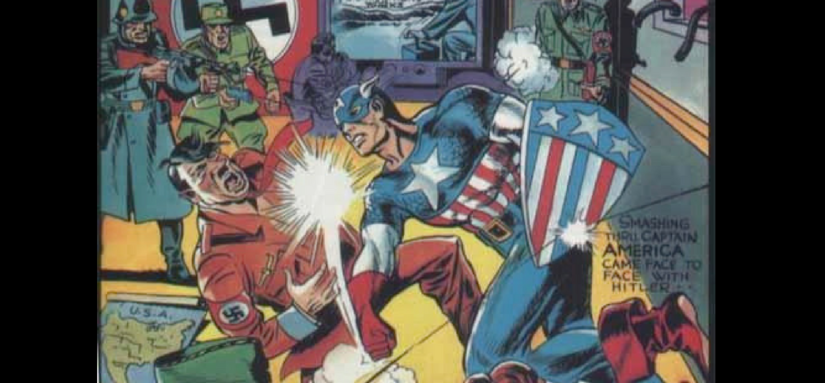

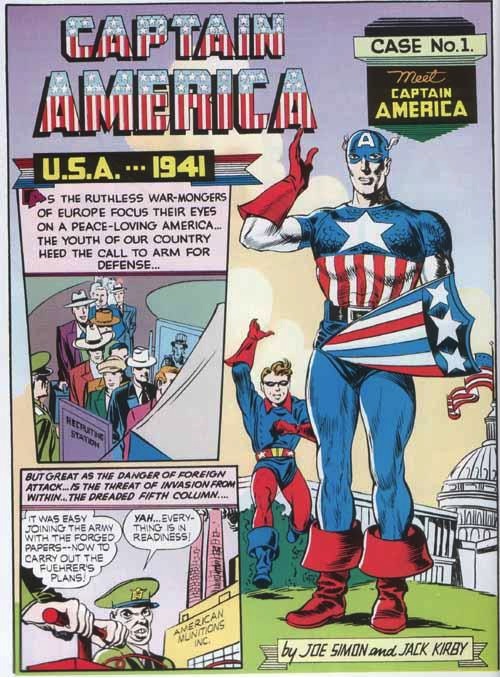
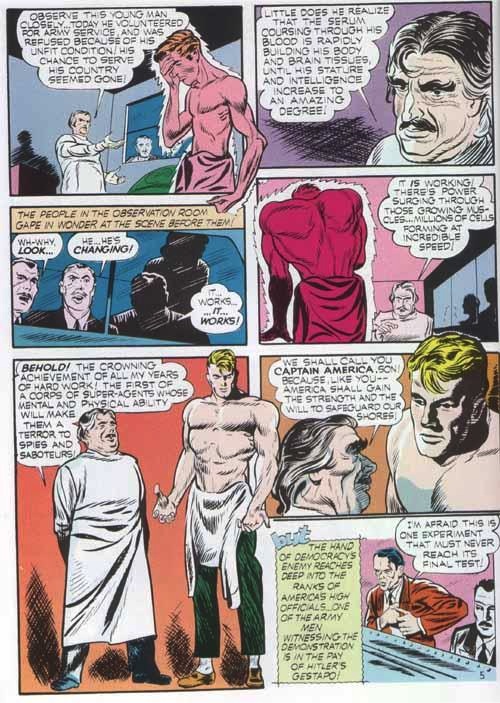
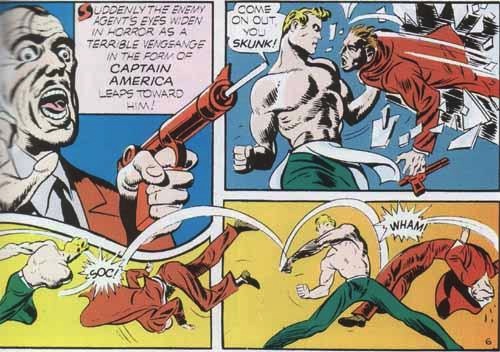
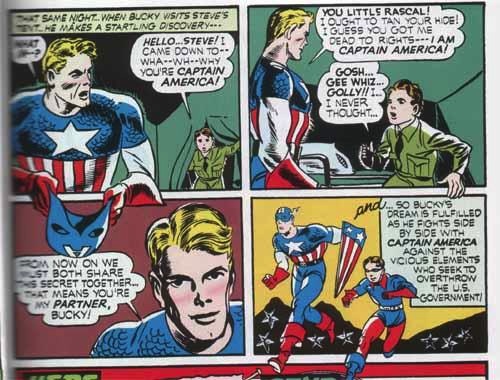
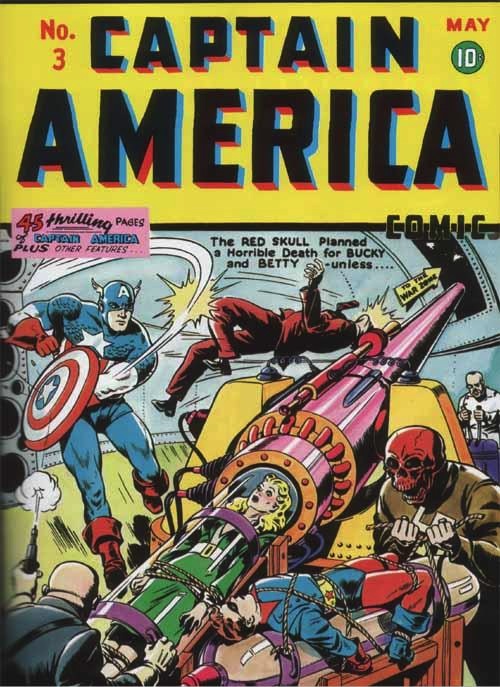
Comments are closed.